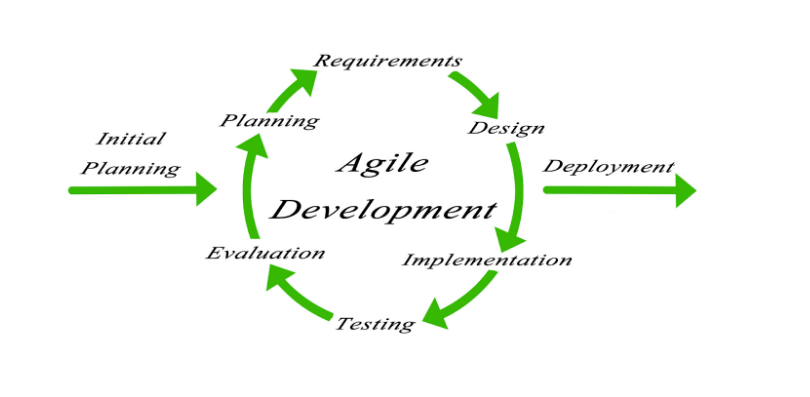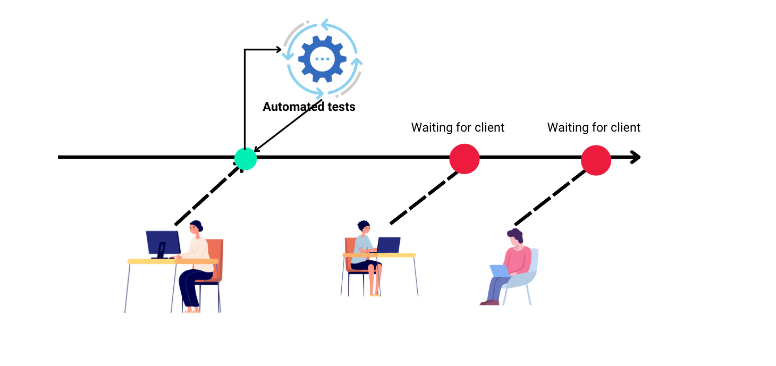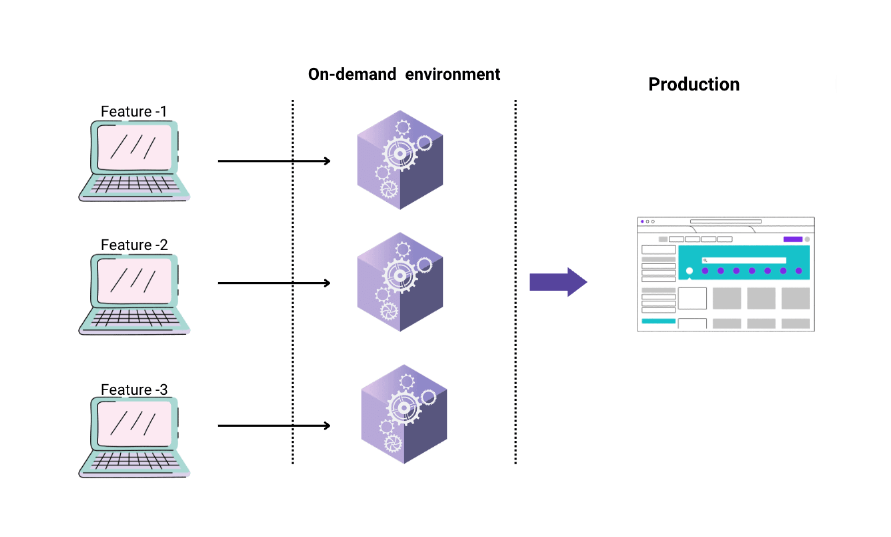
In a continuous integration environment, test automation is essential for ensuring that new code changes do not break existing functionality. By automatically running a suite of tests with every code change, teams can quickly identify and fix any issues that may arise. This allows development to proceed at a much faster pace and reduces the risk of unexpected bugs making it into production. The trend in automated testing is quickly shifting from the usual approach of execution in the CI environment on every PR merge to more modern and lighter techniques. Thanks to On-demand test environments which are enabling such newer and lighter practices to emerge.

Continuous integration is emphasized in agile, with a focus on merging the stable code as frequently as feasible. Some teams adhere to this agile taste to the letter, but others find it a little chaotic and try to strike a balance by encouraging code merges once per day, ideally just before signing off for the day. It seems sense that a test activity requiring human labor would be time-consuming and expensive when there is a constant influx of code into the environment. Testing shift left strategy is embraced in order to establish sanity and guarantee that the new code does not affect the existing ecosystem.
Ready to Get Started?
Let our team experts walk you through how ACCELQ can assist you in achieving a true continuous testing automation
However, there is a catch to this process when many team members make changes and commit to the code. Prior builds must be approved and merged before moving on to the subsequent one, which causes dependencies and delays. Teams are going forward with the feature branch test strategy, commonly known as the on-demand test environment, to reduce these delays.

What is an On-demand test environment?
A completely functional environment that can be spun up at any time is known as an on-demand environment. Before a feature is delivered to the next environment, these test environments are typically set up to test it independently and without any other dependencies. After the tests, these on-demand settings are completely taken apart. There are a few considerations you should make if you want to automate testing in an on-demand test environment. This is covered in the following section of this page.
Feature environments allow you to create a staging environment for each individual feature. The staging environment is a replica of the production environment. It is built on the ephemeral infrastructure that exists purely for the purposes of hosting the build of a given pull request. By doing so, the team can access and test the functionality eliminating the laundry list of dependencies. You will Frequently observe a setup with a shared staging environment, where a lot of features are mashed together, frequently spurred by an unproductive release process, which causes the team to bulk features for every release.

Test Automation on Feature-branch
A clearly defined procedure is one of the most crucial considerations to make when automating your tests. With shared URLs, automated tests may be launched to examine the influence of new code on the total application code, completely eliminating the need for a single infrastructure.
Test engineers can also carry out cross-browser and cross-device testing on the feature branches with a specific emphasis on the newly built feature.. However, it takes discipline and a systematic methodology to perform automated tests on the feature branch. Without a defined procedure, automating your tests might result in a lot of time and effort being lost. Make sure you are completely clear on what needs to be tested and how you intend to test it.
Be part of the lively group discussions covering various topics around Web, API, Mobile Test automation, and more...
Benefits of On-demand test environment
Within the development team, there are numerous advantages to practicing spinning up on-demand test environments. Here are a few examples.
Frequent testing
Because feature branches may be spun up at any time by anyone on the team, it eliminates the need for a specific staging environment. The new features can be tested and provided early feedback by the test engineers even before the code merge.
Test Spectrum coverage
The on-demand feature environment is easily configurable, allowing for a wide range of quality assurance and testing opportunities. It enables cross-browser testing to guarantee that the product works properly across several devices and browsers. UX and content team can have a quick look against the usability concerns.
Enhances team productivity
By removing the reliance on the availability of a specific environment, developers within the team will have more freedom in performing frequent code merges. Additionally, employing automated tests in these on-demand staging environments helps to offer faster feedback on regression checks.
Faster Delivery
A faster time to market is critical to a product's success. The on-demand feature ecosystem contributes to speedier product delivery. Developers can avoid delivering untested features or cherry-picking features for testing in these settings. An on-demand feature environment ensures that all features are thoroughly evaluated before they are integrated into the main branch. This guarantees that all features work as expected and allows for a successful release.
It saves both time and money.
In a typical setup, the staging environment is always made available for testing, incurring in resource waste, especially when the idol is sitting. On-demand feature environments can assist reduce over-calling by swiftly establishing the environment and pulling it down after the user.
Testing in an On-demand environment
On-demand branches are used by test engineers to do feature testing, product owners to validate the new feature produced, and developers to regularly merge code. On-demand environments encourage increased participation and communication among agile development teams in this way. The ability to run cross-browser tests, accessibility tests, minimum performance tests, etc. will also be possessed by test engineers.
Benefits of On-demand test environment
Although an on-demand test environment has many advantages for the development team, it can be quite expensive for the company if the proper procedures and discipline do not support it.
Forgetting to disassemble
Setting up one's own test environment offers freedom but carries a great deal of responsibility. The setting will continue to be billed if it is not disassembled after use.
Need for supportive infrastructure
There are specific infrastructure needs for on-demand test environments. Businesses with various development pipelines in place, such as those with on-premise apps, may not be able to fully utilize this on-demand environment.
Training costs
Each team member needs the training to deal with an on-demand workplace. If not, the team will depend on certain members to foster such conditions, eventually leading to dependencies at various levels.
Conclusion
An on-demand environment nearly always results in faster deployments. Testing all features in collaborative staging environments can be time-consuming and make it challenging to pinpoint the precise line of code that caused the program to malfunction. One may argue that the secret to speedier deployments is the use of on-demand test environments. On-demand test environments can be used to test bug fixes and hot-fixes in addition to features.

Sowmya Sridharamurthy
Sowmya Sridharamurthy is a seasoned product quality leader working as SDET Manager at Lytho. With 14+ years of experience handling products from inception to delivery, she has worked on diverse solutions- ERP, SAAS, Mobile Apps, and Web applications. She has a proven track record of successfully implementing result-driven test processes, non-disruptive migrations, and upgrades. Sowmya is driven to mentor development teams in building effective strategies and implementations to achieve ROI through test automation. Being an Accessibility advocate, she is keen on driving inclusive software development. Sowmya is an active community builder and runs an “APIans” meet-up group from Amsterdam."
Related Posts
 Salesforce testing with a Codeless AI test automation platform ACCELQ
Salesforce testing with a Codeless AI test automation platform ACCELQ
Salesforce testing with a Codeless AI test automation platform ACCELQ
 Regression Testing and Retesting: Key Differences and Best Practices
Regression Testing and Retesting: Key Differences and Best Practices

































